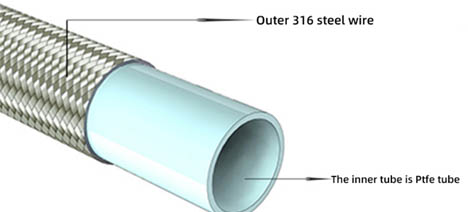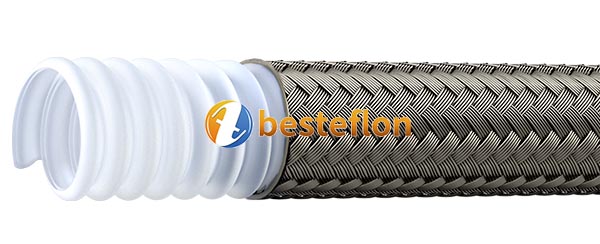When it comes to choosing the right PTFE(Teflon) hose for your application, many buyers face a common challenge: What’s the difference between a smooth bore PTFE hose and a convoluted PTFE hose? Understanding this distinction is crucial for achieving optimal performance, safety, and durability in demanding environments.
This article provides a technical PTFE(Teflon) hose comparison across several key factors, including bend radius, pressure loss, cleanability, and fitting compatibility—helping you select the best PTFE hose for your industry needs.
What Is a Smooth Bore PTFE Hose?
A smooth bore PTFE hose has a completely smooth inner core, typically made from polytetrafluoroethylene (PTFE), which allows for efficient fluid flow. The surface is sleek and non-porous, ideal for applications that require easy cleaning, low friction, and precise fluid delivery.
Common Applications:
Pharmaceutical and biotech fluid transfers
Food & beverage industry (sanitary fluid systems)
Chemical processing with low viscosity fluids
Hydraulic and fuel line systems
What Is a Convoluted PTFE Hose?
A convoluted PTFE hose features a corrugated or spiral-shaped inner surface, designed to increase hose flexibility and allow tighter bend radii. The design may slightly reduce flow efficiency, but it greatly improves maneuverability—especially in tight or complex routing systems.
Common Applications:
Robotics and automated machinery with tight space constraints
Pneumatic or vacuum systems
Chemical transfer in compact or dynamic environments
Flexible piping in OEM assembly
Smooth Bore vs Convoluted PTFE(Teflon) Hose: Technical Comparison
To help you make an informed decision, here’s a detailed PTFE hose comparison across four essential performance factors:
1. Bend Radius
Convoluted PTFE Hose: Offers a tighter bend radius, making it ideal for complex installations with sharp turns or limited space.
Smooth Bore PTFE Hose: Requires a wider bend radius, which can limit use in compact setups.
Winner for flexibility: Convoluted PTFE hose
2. Flow Efficiency & Pressure Loss
Smooth Bore Hose: The internal surface is smooth, which allows uninterrupted flow and results in minimal pressure loss.
Convoluted Hose: The inner ridges can create turbulence, increasing pressure drop across the hose.
Winner for flow performance: Smooth Bore PTFE hose
3. Cleanability & Sanitation
Smooth Bore: Its smooth internal surface makes it easier to flush, sterilize, and clean, especially in CIP/SIP (Clean-In-Place/Sterilize-In-Place) systems.
Convoluted: The grooves can trap residues, making cleaning more difficult in sensitive applications.
Winner for hygienic use: Smooth Bore PTFE hose
4. Fitting Compatibility
Smooth Bore: Compatible with crimped or reusable fittings, but less flexible, requiring careful installation.
Convoluted: More flexible but may need specialized fittings due to the ridged interior.
Winner for ease of routing: Convoluted PTFE hose
Choosing the Right Hose by Industry
Your choice between smooth bore vs convoluted PTFE hose depends on your industry requirements:
Use Smooth Bore PTFE Hoses When:
1.In pharmaceutical production, food and beverage processing, or biotechnology applications, smooth inner walls can prevent bacterial growth and make cleaning work easier.
2.In fuel transportation, compressed air pipelines, or high flow chemical transportation, a smooth inner bore can minimize friction and pressure drop to the greatest extent possible.
3.Precision measurement or measurement system
Use Convoluted PTFE Hoses When:
1. Application of tight bending radius
When the installation space is limited and the hose needs to make sharp turns without creases, such as in compact mechanical layouts or narrow car compartments.
2. High flexibility and toughness requirements
When the hose needs to withstand continuous motion, vibration, or repeated bending, such as in robotic arms, filling machines, or dynamic chemical transfer systems.
3. Transportation of high viscosity or viscous fluids
When pumping thick, viscous or viscous fluids (such as adhesives, syrups, resins), the curved inner wall can reduce back pressure, thereby improving the flow state during suction or discharge
Smooth Bore vs. Convoluted PTFE Hose Application Table
| Scenario | Smooth Bore PTFE Hose | Convoluted PTFE Hose |
| Flow Efficiency | Best for maximum flow with minimal pressure drop. | Slightly more resistance due to corrugations. |
| Tight Bend Radius | Less flexible, not ideal for sharp bends. | Excellent for tight spaces and sharp bends without kinking. |
| Sanitary / Cleanability | Smooth inner wall, easy to clean, ideal for sanitary use. | More difficult to clean; better for non-sanitary environments. |
| Flexibility / Movement | More rigid; suitable for static installations. | Highly flexible, ideal for dynamic or vibrating systems. |
| Vacuum / Suction | Suitable but limited flexibility in vacuum applications. | Excellent vacuum resistance due to convoluted design. |
| Viscous or Sticky Fluids | Not ideal for very thick fluids. | Handles viscous/sticky fluids better under suction or discharge. |
| Precision Metering | Consistent flow, ideal for dosing and instrumentation. | Flow less consistent due to corrugations. |
Final Thoughts: Which One Is Right for You?
There’s no one-size-fits-all answer. The right PTFE hose type depends on your specific application, environmental conditions, and mechanical requirements. If flow efficiency and cleanliness are your top priorities, smooth bore PTFE hoses are the superior choice. If flexibility and bend radius matter most, then convoluted hoses are the better option.
Smooth Bore PTFE Hose or Convoluted PTFE Hose,You May Like
Still unsure whether to choose smooth bore or convoluted PTFE hose for your system? Our technical team offers custom recommendations based on your operating conditions and performance needs. Besteflon Fluorine plastic Industry Co., Ltd. specializes in the production of high-quality PTFE hoses and tubes for 20 years. If any questions and needs, please feel free to consult us for more professional advice.
Post time: Aug-14-2025


